Searching for "OER"
This year we’d like to involve a wider segment of the teaching and learning community to help us design the survey. Please join us online for one of two 30-minute discussion sessions:
Sept 14 at 12pm ET OR Sept 15 at 2pm ET
To join, just go to https://educause.acms.com/eliweb on the date and time of the session and join as a guest. No registration or login needed.
———————————————————————————-
Key Issues in Teaching and Learning 2016
http://www.educause.edu/eli/initiatives/key-issues-in-teaching-and-learning

1. Academic Transformation
3. Assessment of Learning
4. Online and Blended Learning
5. Learning Analytics
6. Learning Space Design
8. Open Educational Resources & Content
9. Working with Emerging Technology
10. Next Gen Digital Learning Environments (NGDLE) & Services
11. Digital & Informational Literacies
12. Adaptive Learning
13. Mobile Learning
14. Evaluating Tech-Based Instructional Innovations
15. Evolution of the Profession
CALL FOR PROPOSALS
IOLUG Fall 2016 Conference – Let Our Powers Combine: Engage. Partner. Inspire
Friday, October 21, 2016
Indiana Wesleyan University North Campus
3777 Priority Way, Indianapolis, IN 46240
How can we join together to increase awareness of the value, impact and services provided by libraries and library professionals in the academic, public and online settings? The IOLUG Program Committee is inviting proposals around the theme of proving the value and worth of the library. Specifically, how are you demonstrating the value of your library? What emerging technologies are you using to display your contribution to your institution or community either online or in person? How can we work together to inspire a spirit of advocacy?
We encourage presentations that are practical, hands-on, and include take-awayable tools, techniques, and/or strategies that librarians can implement to improve their resources and services for students, patrons, faculty, etc. Consider the following topics:
- Promoting open educational resources (OER) and affordable learning materials
- Analytics and metrics
- Supporting diversity
- Improved service delivery and job performance
- Digital media implementation
- New library initiatives
- Innovation and community engagement
- Leadership
Please specify in your proposal whether users will be expected to bring their own devices, or if you will need the use of a computer lab.
Submit your proposal today!
Deadline is Friday, September 2
Get ideas from previous conferences at the IOLUG site.
Digital Badges in Education: Trends, Issues, and Cases.
https://www.routledge.com/products/9781138857605
In recent years, digital badging systems have become a credible means through which learners can establish portfolios and articulate knowledge and skills for both academic and professional settings. Digital Badges in Education provides the first comprehensive overview of this emerging tool. A digital badge is an online-based visual representation that uses detailed metadata to signify learners’ specific achievements and credentials in a variety of subjects across K-12 classrooms, higher education, and workplace learning. Focusing on learning design, assessment, and concrete cases in various contexts, this book explores the necessary components of badging systems, their functions and value, and the possible problems they face. These twenty-five chapters illustrate a range of successful applications of digital badges to address a broad spectrum of learning challenges and to help readers formulate solutions during the development of their digital badges learning projects.

++++++++++++++++++++++
Badges and Leaderboards: Professional Developments for Teachers in K12
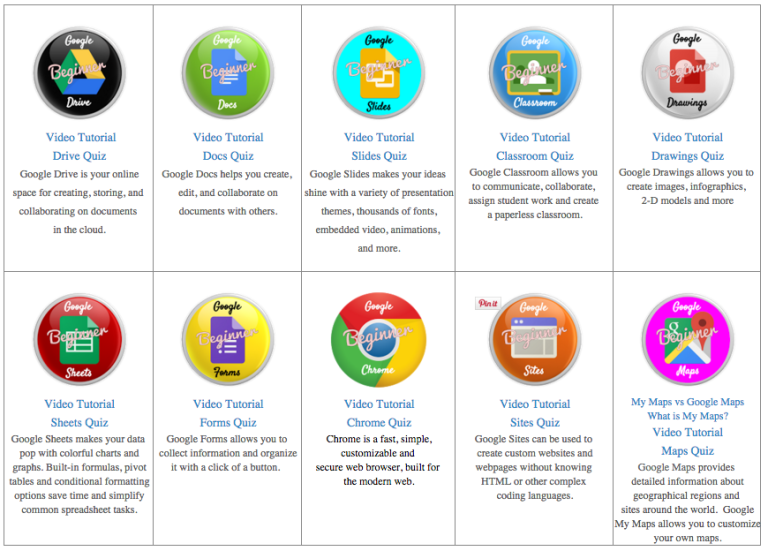
http://www.shakeuplearning.com/blog/more-ideas-for-badges-in-professional-learning/
Why should I bother earning badges?
http://www.connectededucators.org/cem-digital-badges-faq/
++++++++++++++++++++++
Canvas Badges:
https://canvas.instructure.com/courses/904071
++++++++++++++++++++++++
Edmodo Badges:
http://www.helloliteracy.com/2012/09/technologically-speaking-currently.html
+++++++++++++++++++++
issues to consider:

++++++++++++++++++++++++
More on badges and gaming in education in this IMS blog:
https://blog.stcloudstate.edu/ims/?s=badges&submit=Search
purpose: draft a document for the provost to plan for charting the future goal 3.12 “develop a comprehensive strategy to increase awareness and development of e-textbooks and open educational resources (OERs)”
\\STCLOUDSTATE\HuskyNet\DeptFiles\LRS\ETextbooks
SCSU goal: to reduce the cost of textbooks as an affordable learning initiative. Amount of reduction is undetermined
my notes based on the material below:
- best, most applicable source for the purpose of this research: U of Alberta Committee’s notes on the learning environment:
http://www.governance.ualberta.ca/en/GeneralFacultiesCouncil/CommitteeontheLearningEnvironm/~/media/Governance/Documents/GO05/LEA/15-16/WEB/Item-4-eTextbook-Subcommittee-Report-CLE-TLAT.pdf
the Canadians are using (citing) Acker (Ohio) in their research.
- best, most applicable source in terms of the logistics on e-texbooks creation and its pedagogical argumentation is this document from New Zealand: https://akoaotearoa.ac.nz/download/ng/file/group-7/guidelines-for-developing-interactive-etextbooks-on-net-tablets.pdf
- According to Bossaler et al (2014), it might be worth considering that SCSU (MnSCU?) must go first through implementing of e-text[books] in courses first by using publisher materials and then by using “in-house” produce. At this point, SCSU does NOT have an aligned policy of integrating e-texts in courses across campus. Lack of such experience might make a strategy for adoption of e-textbooks much more complex and difficult to implement
- stats are colored in green for convenience. Stats regarding the increase in textbook costs are re-printed from author to author: e.g. Acker (2011, p. 42). Murey and Perez (2011, p. 49 (bottom) – 50 (up)) reports stats from 2009 and projections for 2013 regarding etexbook adotion. Same authors, p. 50 second paragraph reports good stats regarding texbooks’ price increase : US$1122 per year for textbooks in 2010.
- Wimmer at al (2014) presents a lucid graphic of the structure of the publishing process (see bottom of this blog entry for citation and perm link).
- Wimmer at al (2014) discusses copyright and permissions, which is of interest for this research (p. 85)
- regarding in-house creation of e-textbooks, see (Distance education, e-learning, education and training, 2015). It very much follow the example of SUNY, which Keith was laying out: a team of faculty charged with creation the e-textbook for mass consumption.
Besides the SUNY model Keith is envisioning for MnSCU (comparable), there is the option of clustering OER sources: e.g. NASTA as per Horejsi (2013), CourseSmart. FlatWorld Knowledge (Murrey and Perez, 2011) etc.
- Hamedi & Ezaleila (2015) present an entire etextbook program. Article has been ordered through ILL. Same with Joseph (2015).
- Open Educational Resources in Acker (2015, p. 44-47). Also in Murey and Perez (2011, p. 51).
Also in ICWL (Conference) (13th : 2014 : Tallinn, E., & Cao, Y. (2014): OpenDSA
- Different models of pricing also in Acker (2015, p. 48). Keith touched on that
- students learn equally well from etextbooks as from paper ones: Taylor (2011)
- pedagogy
responses from colleagues:
Scott Robison, sarobison@mail.plymouth.edu: sparc-liboer@arl.org listserv
Jeff Gallant, Jeff.Gallant@usg.edu: David Ernst with the U and Ashley Miller from Ohio State U: dernst@umn.edu. Ashley’s is miller.6275@osu.edu.
definition e-textbook and
an electronic version of a printed book that can be read on a computer or handheld device designed specifically for this purpose.
-
a dedicated device for reading electronic versions of printed books.
Definition of: e-book
my note: there is no good definition about e-textbook in terms of the complexity, which e-textbook on campus might involve.
Considering Wimmer et al (2014) account on their campus experience in publishing e-textbook, a textbook may involve an LMS (Canvas) and blog (WordPress). Per my proposal during the F2F meeting, and following Rachel’s suggestion about discrimination of the different types of e-textbooks, here is an outline of e-textbook definition:
*******************
working definition for e-textbook for the purposes of SCSU:
e-textbook is a compilation of textual, multimedia and interactive material, which can be viewed on various electronic devices. E-textbook can: 1. be purchased from a publisher; 2. compiled in HTML format on faculty or group web space; 3. compiled on the content module of LMS (BB, D2L, Canvas, Moodle, etc.) 4. compiled on LMS (BB, D2L, Canvas, Moodle, etc.) and including all interactive materials: e.g. hyperlinks to MediaSpace multimedia, quizzes, etc.; 5. compiled on special apps, such as iBook Author, eCub, Sigil.
*******************
e-book
(Electronic-BOOK) The electronic counterpart of a printed book, which can be viewed on a desktop computer, laptop, smartphone, tablet or e-book reader (e-reader). When traveling, a huge number of e-books can be stored in portable units, dramatically eliminating weight and volume compared to paper. Electronic bookmarks make referencing easier, and e-book readers may allow the user to annotate pages.
Although fiction and non-fiction books come in e-book formats, technical material is especially suited for e-book delivery because it can be searched. In addition, programming code examples can be copied, which is why CD-ROMs that contained examples or the entire text were often packaged inside technical paper books.
E-Book Formats
Wimmer, Morrow, & Weber: Collaboration in eTextbook Publishing
There are several e-book formats on the market, including EPUB, Mobipocket (PRC, MOBI), eReader (PDB), Kindle (AZW, KF8) and Apple iBook (EPUB variation). Many e-readers also accept generic formats, including Adobe PDF and plain text (TXT).
——————
Electronic Textbooks or Paper Textbooks: What Are Students Reading?
According to a United States Government report, textbook prices have increased at over twice the rate of inflation in the last couple of decades. According to another report, the average student spends between $700 and $1,000 per year on textbooks while the cost of e-textbooks can be as much as 50% lower than paper textbooks.
Oxford dictionary, an electronic book or e-book is “an electronic version of a printed book that can be read on a computer or handheld device designed specifically for this purpose.” An e-textbook is defined as an e-book used for instructional or educational purposes and often includes features such as bookmarking, searching, highlighting, and note-taking as well as built-in dictionaries and pronunciation guides, embedded video-clips, embedded hyperlinks, and animated graphics.
E-textbooks have moved from occasional usage to a mainstream technology on college campuses. According to the Association of American Publishers, sales of e-books hit over $90 million; this is up over 200% when compared to the same month the previous year. When the cost of textbooks and the availability of formats are considered, the use of an e-textbook in the classroom may be the reasonable choice.
—————–
A
digital textbook is a digital book or
e-book intended to serve as the text for a class. Digital textbooks may also be known as
e-textbooks or
e-texts. Digital textbooks are a major component of technology-based education reform. They may serve as the texts for a traditional face-to-face class, an online course or degree.
The concepts of
open access and
open source support the idea of
open textbooks, digital textbooks that are free (gratis) and easy to distribute, modify and update
https://en.wikipedia.org/wiki/Digital_textbook—————-
Exploring Students’ E-Textbook Practices in Higher Education
- Authors: by Aimee Denoyelles, John Raible and Ryan Seilhamer Published: Monday, July 6, 2015. Instructional Designers, University of Central Florida
According to the United States Government Accountability Office, prices have increased 82 percent from 2002 to 2012.3 This cost sometimes drives students to
delay or avoid purchasing textbooks. Digital materials such as e-textbooks may offer a more cost-effective alternative.
4 Also, the expectation for digital materials is gaining strength in the K–12 sector.
5 For example, Florida school districts set a goal to spend at
least half of classroom material funding on digital materials by the 2015–2016 school year. Given that 81 percent of first-time-in-college (FTIC) undergraduate students hailed from a Florida public high school during the fall 2014 semester at the University of Central Florida (UCF), it is important to anticipate student expectations of digital materials. Finally, the availability of digital materials has risen exponentially with the incredible popularity of mobile devices.
Key Issues
Despite the advantages that e-textbooks pose, such as interactive features and accessibility on mobile devices, several barriers exist regarding implementation in higher education, namely non-standardization of the platform, limited use by students, and the unclear role of the instructor in adoption.
a survey questionnaire in 2012 that explored basic usage and attitudes regarding e-textbooks.
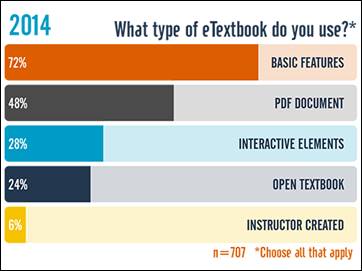




—————————–
Bossaller, J., & Kammer, J. (2014). Faculty Views on eTextbooks: A Narrative Study. College Teaching, 62(2), 68-75. doi:10.1080/87567555.2014.885877
http://login.libproxy.stcloudstate.edu/login?qurl=http%3a%2f%2fsearch.ebscohost.com%2flogin.aspx%3fdirect%3dtrue%26db%3dkeh%26AN%3d95094045%26site%3dehost-live%26scope%3dsite
Implementing eTexts into a Course:
- planning
- developing
- implementing
- delivering
This qualitative study gives insight into the experiences instructors have when working with publishers to integrate electronic content and technology into their courses.
Baek, E., & Monaghan, J. (2013). Journey to Textbook Affordability: An Investigation of Students’ Use of eTextbooks at Multiple Campuses. International Review Of Research In Open And Distance Learning, 14(3), 1-26.
http://eric.ed.gov/?id=EJ1017493
the Advisory Committee on Student Financial Assistance (2007) reported that textbook prices represent a significant barrier to students’ accessibility to textbooks. The report concluded that textbooks cost between $700-$1000 per year; textbook prices have risen much faster than other commodities; and that college aid fails to cover textbook expenses. Textbook costs are equivalent to 26% of tuition costs for an average four-year public university student and 72% of tuition costs for an average community college student. In fact, the California State Auditor (2008) reported that textbook costs grew more rapidly than student fees in academic year 2007–08.
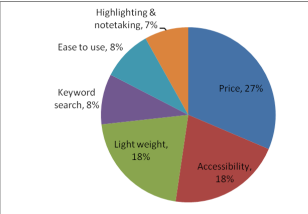
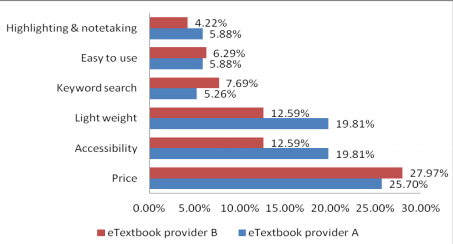
++++++++++++
Wimmer, E. e., Morrow, A. a., & Weber, A. a. (2014). Collaboration in eTextbook Publishing: A Case Study.Collaborative Librarianship, 6(2), 82-86.
http://login.libproxy.stcloudstate.edu/login?qurl=http%3a%2f%2fsearch.ebscohost.com%2flogin.aspx%3fdirect%3dtrue%26db%3dllf%26AN%3d108762075%26site%3dehost-live%26scope%3dsite
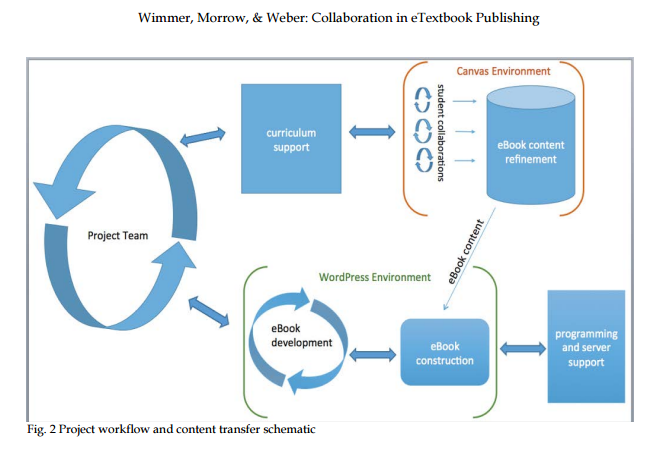
Distance education, e-learning, education and training. (2015). Clinical Chemistry & Laboratory Medicine, 53s557-s559. doi:10.1515/cclm-2015-5015
http://login.libproxy.stcloudstate.edu/login?qurl=http%3a%2f%2fsearch.ebscohost.com%2flogin.aspx%3fdirect%3dtrue%26db%3daph%26AN%3d102854748%26site%3dehost-live%26scope%3dsite
the creation of an interactive e-book called “Practical Clinical Chemistry: core concepts” was accomplished using the
Apple Macintosh platform and the iBooks Author software. Digital content, including videos, was developed for the
project and embedded within the final package. In order to limit the size of the final files, some content was uploaded
onto Youtube so that the user could access these via the internet.
The e-book, 200MB in size, was uploaded onto the Apple ITunes site and made available in 51 countries via the
iBooks store. This prototype is the first interactive digital textbook available in clinical chemistry and contains “4-
dimensional” content including digital images, videos, interactive presentations, real-time data generation as well as
review questions with instant feedback and assessment.
Hamedi, M., & Ezaleila, S. (2015). Digital Textbook Program in Malaysia: Lessons from South Korea. Publishing Research Quarterly, 31(4), 244-257. doi:10.1007/s12109-015-9425-4
Joseph, R. (2015). Higher Education Book Publishing-from Print to Digital: A Review of the Literature. Publishing Research Quarterly, 31(4), 264-274. doi:10.1007/s12109-015-9429-0
the author reflects the process on a state level (Ohio).
Marcoux, E. “. (2012). Best of the Best Planning. Teacher Librarian, 39(4), 69-70.
Taylor, A. K. (2011). Students Learn Equally Well From Digital as From Paperbound Texts. Teaching Of Psychology, 38(4), 278-281. doi:10.1177/0098628311421330
Much of the research related to digital texts has focused ontechnical aspects of readability (see Dillon, 1992, for a review) and limitations of digital media for note-taking, underlining, or highlighting text (Brown, 2001). However, the important—and unanswered—question from a teaching perspective is, ‘‘Can students learn as well from digital texts as from paperbound textbooks?’’ Few published studies have addressed this ques-tion directly, and even fewer studies have examined this ques-tion among college students.
Murray, M. C., & Pérez, J. (2011). E-Textbooks Are Coming: Are We Ready?. Issues In Informing Science & Information Technology, 849-60.
read the entire article, good data.
CourseSmart. FlatWorld Knowledge,
Horejsi, M. (2014). Textbooks 2.0. Science Teacher, 81(3), 8. http://login.libproxy.stcloudstate.edu/login?qurl=http%3a%2f%2fsearch.ebscohost.com%2flogin.aspx%3fdirect%3dtrue%26db%3daph%26AN%3d94603788%26site%3dehost-live%26scope%3dsite
++++++++++++++
pedagogy
two Eastern Europeans (Moldova, Serbia) raise serious concerns about electronic textbooks
Španović, S. (2010). PEDAGOGICAL ASPECTS OF E-TEXTBOOKS. Odgojne znanosti. 12(2). 459-470.
Railean, E. (2015). https://prezi.com/sbidiadctrzo/beyond-textbook-digital-textbook-use-and-development/
http://www.governance.ualberta.ca/en/GeneralFacultiesCouncil/CommitteeontheLearningEnvironm/~/media/Governance/Documents/GO05/LEA/15-16/WEB/Item-4-eTextbook-Subcommittee-Report-CLE-TLAT.pdf :
- (Un)desirable features in etextbooks
- How etextbooks might affect course delivery
- Pilot projects that can help build institutional expertise
- Address how and where insights gained from pilot projects will be collected and
- made available
- People resources (e.g., instructional designers) that will be needed to assist
- instructors to use this technology
ICWL (Conference) (13th : 2014 : Tallinn, E., & Cao, Y. (2014). New horizons in web based learning: ICWL 2014 international workshops, SPeL, PRASAE, IWMPL, OBIE, and KMEL, FET, Tallinn, Estonia, August 14-17, 2014, revised selected papers. Cham: Springer.
++++++++++++++++++++
MnSCU will by as Content Authoring Tool – SoftChalk. Here is a promo from Softchalk (my bold):
NEW SoftChalk Create 10 and SoftChalk Cloud eBook publishing features will arrive on April 25th! Come check out the latest enhancements at our upcoming webinars!
Sleek Designer Headers and Callout Boxes – Add some new pizazz to your SoftChalk lessons!
Three New Quiz Types – Test your students’ understanding with Sentence Completion, Multiple Blanks and Feedback Questions.
Polished New QuizPopper and Activity displays – With an enhanced interface for instructors and students.
Accessibility enhancements – Make your lessons available to everyone with even more accessibility enhancements.
NEW SoftChalk Cloud eBook creation and publishing – Includes a totally re-vamped, easier eBook creation and management. New SoftChalk eReader apps available for free download in the iOS, Android, Chromebook and Windows app stores. (Cloud Only)
+++++++++++++++++++++++++++
The future of textbooks looks like this
February 22nd, 2016
are any faculty really going digital? Which content distributors will thrive? What are the implementation concerns? And when will going digital really happen?
two massive surveys and reports by the National Association of College Stores (NACS) and the Independent College Bookstore Association (ICBA) in partnership with the Campus Computing Survey (CCS),
A Librarian’s Guide to OER in the Maker Space
http://www.slj.com/2015/10/technology/a-librarians-guide-to-oer-in-the-maker-space
OER are teaching, learning, and research resources that reside in the public domain or have been released under an intellectual property license that permits sharing, accessing, repurposing—including for commercial purposes—and collaborating with others. They include educational materials, such as lesson plans, games, textbooks, tests, audio, and video. In addition to being free, these no-cost teaching and learning materials are available online for anyone to use, modify or share with others.This use, reuse, and remixing of instructional materials is a powerful way to gain and share knowledge. Because OER are customizable and flexible, they can be used very effectively to support students to achieve their learning goals.
OER Commons is a digital library where educators can find resources to develop, support and amplify their maker space practices. The site is searchable by subject, grade level or standard. Users can also filter results to include topics, such as activities and labs, games, videos, lesson plans, and interactive tools.
Related blog entry:
https://blog.stcloudstate.edu/ims/2016/02/22/libraries-and-learning/
What’s Hot, What’s Not in 2016
Our expert panelists weigh in on education technology to give us their verdict on which approaches to tech-enabled learning will have a major impact, which ones are stagnating and which ones might be better forgotten entirely.
By Greg Thompson 01/12/16
https://thejournal.com/articles/2016/01/12/whats-hot-whats-not-in-2016.aspx
-
Bring Your Own Device (BYOD): Lukewarm to Hot
-
Social Media for Teaching and Learning: Lukewarm to Hot
-
Digital Badges: Mostly Lukewarm
-
Open Educational Resources (OERs): Mostly Hot
-
E-Portfolios: Losing Steam
-
Learning Management Systems (LMS): Lukewarm to Hot
-
Flipped Learning: Mostly Hot (but Equitability a Question)
-
Blended Learning: Unanimously Hot
-
Student Data Privacy Concerns: Unanimously Hot
-
Apps for Learning: A Mostly Lukewarm Mixed Bag
-
Games for Learning: Hot
What are the hot devices?
Cameras like the Canon VIXIA, the Sony HDR-MV1 or the Zoom Q4 or Q8 range from $200 to $400. The secret of these small devices is a tradeoff between video flexibility and audio power. With digital-only zoom, these cameras still deliver full HD video (or better) but with limited distance capabilities. In return, the audio quality is unsurpassed by anything short of a professional boom or wireless microphone setup; most of these cameras feature high-end condenser microphone capsules that will make music or interview recordings shine.
The Chromebook is hot. Seventy-two percent of Chromebook sales were education-related purchases in 2014.
The smartphone is hot. Every day, the smartphone becomes less of a “phone” and more of a device for connecting with others via social media, researching information on the Internet, learning with apps and games and recording experiences with photos and videos.
Social network platforms for HigherEd
Excellent discussion on the blend-online listserv on :
Can anyone recommend a good social network platform, preferably Cloud-based, that could be used to facilitate substantive organic communication and collaboration among past, present and future students on a handful of online and blended learning programs?
From: The EDUCAUSE Blended and Online Learning Constituent Group Listserv [mailto:BLEND-ONLINE@LISTSERV.EDUCAUSE.EDU] On Behalf Of Robert Tousignant
Sent: Wednesday, January 21, 2015 11:50 AM
To: BLEND-ONLINE@LISTSERV.EDUCAUSE.EDU
Subject: Re: [BLEND-ONLINE] Social network platforms for HigherEd
Also, as mentioned in my previous post, Schoology (http://www.schoology.com) offers an LMS with a modern social media interface and integrations with Facebook, Microsoft OneDrive, etc… you might want to add it to the list as well.
Bes,
Bob
From: Victoria Cardullo <vmc0004@AUBURN.EDU>
Reply-To: The EDUCAUSE Blended and Online Learning Constituent Group Listserv <BLEND-ONLINE@LISTSERV.EDUCAUSE.EDU>
Date: Wednesday, January 21, 2015 at 12:37 PM
To: “BLEND-ONLINE@LISTSERV.EDUCAUSE.EDU” <BLEND-ONLINE@LISTSERV.EDUCAUSE.EDU>
Subject: Re: [BLEND-ONLINE] Social network platforms for HigherEd
I added both thanks for the update and clarification.
| Facebook Group |
“Groups for Schools” feature today which will allow American colleges to create Group pages accessible only within the school community. |
| LinkedIn |
LinkedIn is a business-oriented social networking service. Founded in December 2002 and launched on May 5, 2003, it is mainly used for professional networking. |
| K-12 Edmodo |
Edmodo is a social networking site for teachers and students where over 46 million teachers, students, and parents are connecting to collaborate on assignments, discover new resources. Edmodo is a web 2.0 social networking tool for educators to use to communicate with students and parents. |
| Microsoft OneDrive |
A file hosting service that allows users to upload and sync files to a cloud storage and then access them from a Web browser or their local device. |
| 12manage.com |
A free management education and business education platform for management and organization of business or education. |
| Yammer |
Yammer a private social network collaboration software and business applications that allows the user to connect to the right people, share information across teams and organize around projects. |
| Celly |
Celly is a platform for ad-hoc social networks that is accessible via iPhone, Android, Web, SMS text and even email. Networks connect individuals and communities for instant and easy communication. |
| Jive |
Jive is a communication and collaboration platform solution for business. Jive enables employees, partners and customers to work together. |
| Twitter |
Twitter is a powerhouse for marketing, communication, business, and even education, letting people from around the world work together, share ideas, and gain exposure to concepts. |
| Google+ Communities |
Google+ is a place to connect with friends and family, and explore interests. Google+ allows the user to share photos, send messages, and stay in touch with the people globally. |
| Hive Social |
Hive Social is a specialist Social Media consultancy, that helps businesses and brands find, connect, build and engage with their online audience through Social Media and Digital Marketing. |
| Enterprise Hive |
HiveSocial for higher education is an enterprise social software, communication and collaboration platform with embedded game mechanics |
| Socialtext |
Socialtext applies Web 2.0 technologies such as enterprise microblogging, enterprise social networking and wikis to the critical challenges facing businesses. Socialtext’s platform allows employees to share expertise, speed workflows, and get their jobs done faster. |
| Elgg |
Elgg an open source social networking software that provides individuals and organizations with the components needed to create an online social environment. It offers blogging, microblogging, file sharing, networking, and groups |
Dr. Victoria Cardullo
Auburn University
Assistant Reading Professor
Curriculum and Teaching
vmc0004@auburn.edu
334-844-6882
“Learning is finding out what you already know, Doing is demonstrating that you know it, Teaching is reminding others that they know it as well as you do. We are all learners, doers, and teachers.”
— Richard David Bach
From: The EDUCAUSE Blended and Online Learning Constituent Group Listserv [BLEND-ONLINE@listserv.educause.edu] on behalf of Kampmann, David L [David.Kampmann@SOUTHEASTTECH.EDU]
Sent: Tuesday, January 20, 2015 3:02 PM
To: BLEND-ONLINE@listserv.educause.edu
Subject: Re: [BLEND-ONLINE] Social network platforms for HigherEd
A Facebook group is probably the quickest, easiest, and will give you the best engagement. Data shows that in the under 25 age group, Facebook groups is still popular.
If you were trying to reach mainly current and future, I would shift to LinkedIn.
All of those other social networks and white label networks require people to remember another log in, site, and place to check and update. You might get good engagement up front, but it will deteriorate.
David Kampmann, M.S. in Ed, CFD | Southeast Technical Institute
Instructional Facilitator | p: (605) 367-5531 | @mrkampmann
From: The EDUCAUSE Blended and Online Learning Constituent Group Listserv [mailto:BLEND-ONLINE@LISTSERV.EDUCAUSE.EDU] On Behalf Of Ed Garay
Sent: Tuesday, January 20, 2015 11:07 AM
To: BLEND-ONLINE@LISTSERV.EDUCAUSE.EDU
Subject: [BLEND-ONLINE] Social network platforms for HigherEd
Can anyone recommend a good social network platform, preferably Cloud-based, that could be used to facilitate substantive organic communication and collaboration among past, present and future students on a handful of online and blended learning programs?
I am familiar with Google+ Communities, Yammer, Jive and Socialtext, but I am wondering if there are other solutions worth investigating. Facebook at Work might be a possibility, but it is too early to tell. Elgg is also a viable option, especially, a hosted Elgg instance, but identifying a fully functional, customizable and super easy to use and administrate Cloud-first solution is most desirable.
Thank you very much.
— Ed Garay
University of Illinois at Chicago
http://www.twitter.com/garay
google.com/+EdGaray
IPad.
Levine, A. (2012).
Generation on a Tightrope: A Portrait of Today’s College Student (1 edition). San Francisco: Jossey-Bass. as reported in the IMS blog of:
https://blog.stcloudstate.edu/ims/2014/01/08/visit-to-mankato-cetl/
Additional bibliography:
http://generationz.com.au/education/
Rosenfeld, E., & Loertscher, D. V. (2007). Toward a 21st-Century School Library Media Program. Scarecrow Press.
https://books.google.com/books?hl=en&lr=&id=brLbpR6dI8sC&oi=fnd&pg=PA235&dq=generation+z&ots=9CSv7vT6Bn&sig=RAKh-H98EVQ8x61YbnExS02ZlV8#v=onepage&q=generation%20z&f=false
Jeff Feiertag, & Zane L. Berge. (2008). Training Generation N: how educators should approach the Net Generation.
Education + Training,
50(6), 457–464.
http://doi.org/10.1108/00400910810901782 http://www.emeraldinsight.com/doi/full/10.1108/00400910810901782
Malone, K. (2007). The bubble‐wrap generation: children growing up in walled gardens.
Environmental Education Research,
13(4), 513–527.
http://doi.org/10.1080/13504620701581612 http://www.tandfonline.com/doi/abs/10.1080/13504620701581612
some of the changes in childhood environmental behaviours I explore children and parent relationships, in particular, the phenomena of ‘bubble‐wrapping’ children to appease the anxieties of some middle class parents.
Ivanova, A., & Ivanova, G. (2009). Net-generation Learning Style: A Challenge for Higher Education. In
Proceedings of the International Conference on Computer Systems and Technologies and Workshop for PhD Students in Computing (pp. 72:1–72:6). New York, NY, USA: ACM.
http://doi.org/10.1145/1731740.1731818 http://dl.acm.org/citation.cfm?id=1731818
Ivanova, A., & Smirkarov, A. (2009). The New Generations of Students and the Future of e – Learning in Higher Education. Presented at the International Conference on e – Learni ng and the Knowledge Society – e – Learning’09. Retrieved from
http://www.iit.bas.bg/esf/docs/2009/thenewgenerationsstudentsfuturee-learninghigheredu.pdf
Montana, P., & Petit, F. (2008). MOTIVATING GENERATION X AND Y ON THE JOB AND PREPARING Z.
GLOBAL JOURNAL OF BUSINESS RESEARCH,
2(2), 1–30.
http://www.theibfr.com/ARCHIVE/GJBR-V2-N2-2008.pdf
McCrindle, M. (n.d.).
Understanding Generation Y . The Australian Leadership Foundation. Retrieved from
http://emoneco.net/info_docs/UnderstandingGenY.pdf
Igel, C., & Urquhort, V. (2012). Generation Z, meet cooperative learning.
Middle School Journal,
43(4), 16–21.
http://www.jstor.org/stable/41432109?seq=1#page_scan_tab_contentsLevickaite, R. (2010). Generations X, Y, Z: how social networks form the concept of the world without borders (the case of Lithuania)/Y, X, Z kartos: pasaulio be sienu idejos formavimas naudojantis socialiniais tinklais (Lietuvos Atvejis).
LIMES,
3(2), 170. Retrieved from
http://go.galegroup.com/ps/i.do?id=GALE%7CA250135086&v=2.1&u=stcloud_main&it=r&p=EAIM&sw=w&asid=934b505505fbc57b849a3fb9eefe7871
Lynch, K., & Hogan, J. (2012). How Irish Political Parties are Using Social Networking Sites to Reach Generation Z: an Insight into a New Online Social Network in a Small Democracy.
Irish Communication Review,
13. Retrieved from
http://arrow.dit.ie/cgi/viewcontent.cgi?article=1124&context=buschmarart
Parker, K., Czech, D., Burdette, T., Stewart, J., Biber, D., Easton, L., … McDaniel, T. (2012). The Preferred Coaching Styles of Generation Z Athletes: A Qualitative Study. Journal of Coaching Education, 5(2), 5–97.
Greydanus, D. E., & Greydanus, M. M. (2012). Internet use, misuse, and addiction in adolescents: current issues and challenges.
International Journal of Adolescent Medicine and Health,
24(4), 283–289.
http://doi.org/10.1515/ijamh.2012.041
——————–
more on Generation Z in this IMS blog
https://blog.stcloudstate.edu/ims/?s=generation+z&submit=Search
https://blog.stcloudstate.edu/ims/2015/09/19/gen-z/
https://blog.stcloudstate.edu/ims/2014/03/27/who-is-coming-to-college-after-the-millennials/
digital storytelling across the curriculum
Bernard, R. (2015). The effective uses of digital storytelling as a teaching and learning tool. In: Flood, J., Heath, S. B., & Lapp, D. (Eds).
Handbook of Research on Teaching Literacy Through the Communicative and Visual Arts, Volume II: A Project of the International Reading Association. Routledge.
https://books.google.com/books?hl=en&lr=&id=cIx4CAAAQBAJ&oi=fnd&pg=PA429&dq=digital+storytelling+across+the+curriculum&ots=KpqFoWGQmm&sig=ZQJZkqfn_uE-2L4tqpBmVEiafXo#v=onepage&q=digital%20storytelling%20across%20the%20curriculum&f=false
Sessoms, D. (2008). DIGITAL STORYTELLING: Training Pre-service Teachers to Use Digital Storytelling Across the Curriculum. In K. McFerrin, R. Weber, R. Carlsen & D. Willis (Eds.), Proceedings of Society for Information Technology & Teacher Education International Conference 2008 (pp. 958-960). Chesapeake, VA: Association for the Advancement of Computing in Education (AACE). http://www.editlib.org/p/27300/
Yuksel, P., Robin, B. & McNeil, S. (2011). Educational Uses of Digital Storytelling all around the World. In M. Koehler & P. Mishra (Eds.), Proceedings of Society for Information Technology & Teacher Education International Conference 2011 (pp. 1264-1271). Chesapeake, VA: Association for the Advancement of Computing in Education (AACE). http://www.editlib.org/p/36461/
Ohler, J. (2008). Digital storytelling in the classroom : new media pathways to literacy, learning, and creativity /. Corwin Press.
Rudnicki, A., Cozart, A., Ganesh, A., Markello, C., Marsh, S., McNeil, S., Mullins, H., Odle Smith, D. & Robin, B. (2006). The Buzz Continues…The Diffusion of Digital Storytelling across disciplines and colleges at the University of Houston. In C. Crawford, R. Carlsen, K. McFerrin, J. Price, R. Weber & D. Willis (Eds.), Proceedings of Society for Information Technology & Teacher Education International Conference 2006 (pp. 717-723). Chesapeake, VA: Association for the Advancement of Computing in Education (AACE).
http://www.editlib.org/p/22130/
Churchill, N., Ping, L. C., Oakley, G., & Churchill, D. (2008). DIGITAL STORYTELLING AND DIGITAL LITERACY LEARNING. In
Rea dings in Education and Technology: Proceedings of ICICTE 200.
http://www.icicte.org/ICICTE2008Proceedings/churchill043.pdfDigital Storytelling and Philosophy | Sociology | Anthropology | History classes:
Oppermann, M. (2008). Digital Storytelling and American Studies Critical trajectories from the emotional to the epistemological.
Arts and Humanities in Higher Education,
7(2), 171–187.
http://doi.org/10.1177/1474022208088647 http://ahh.sagepub.com/content/7/2/171.short
Burgess, J. (2006). Hearing Ordinary Voices: Cultural Studies, Vernacular Creativity and Digital Storytelling.
Continuum,
20(2), 201–214.
http://doi.org/10.1080/10304310600641737 http://www.tandfonline.com/doi/abs/10.1080/10304310600641737?journalCode=ccon20
Williams, J. B., Bedi, K., & Goldberg, M. A. (2006).
The Impact of Digital Storytelling on Social Agency: Early Experience at an Online University (SSRN Scholarly Paper No. ID 1606104). Rochester, NY: Social Science Research Network. Retrieved from h
ttp://papers.ssrn.com/abstract=1606104 http://papers.ssrn.com/sol3/papers.cfm?abstract_id=1606104
Tatum, M. (2009). Digital Storytelling as a Cultural-Historical Activity: Effects on Information Text Comprehension.
Open Access Dissertations. Retrieved from
http://scholarlyrepository.miami.edu/oa_dissertations/222
Digital Storytelling and Education:
IVala, E., Chigona, A., Gachago, D., & Condy, J. (2012). Digital Storytelling and Student Engagement: A Case of Pre-Service Student Teachers and their Lecturers’ at a University of Technology – ProQuest. Presented at the International Conference on e-Learning. Retrieved from
http://search.proquest.com/openview/498ddf3873e0433dd9ef1b0a67c1d9a9/1?pq-origsite=gscholarDigital Storytelling and Communication Studies | Mass Communication:
Tharp, K., & Hills, L. (2004). Digital Storytelling: Culture, Media and Community. In: Marshall, S., Taylor, W., & Yu, X. H. (Eds). Using Community Informatics to Transform Regions. Idea Group Inc (IGI).
Raimist, R., Doerr-Stevens, C., & Jacobs, W. (2010). Seminar – The Pedagogy of Digital Storytelling in the College Classroom.
International Journal of Media, Technology & Lifelong Learning,
6(2). Retrieved from
http://seminar.net/volume-6-issue-2-2010/145-the-pedagogy-of-digital-storytelling-in-the-college-classroom
Boa-Ventura, A., & Rodrigues, I. (2010). “Making news with digital stories: digital storytelling as a forma of citizen journalism – case Studies analysis in the U.S., UK and Portugal.
Revista PRISMA.COM,
0(7). Retrieved from
http://revistas.ua.pt/index.php/prismacom/article/view/674
#MNsummit2015
Main speaker
Aaron Doering
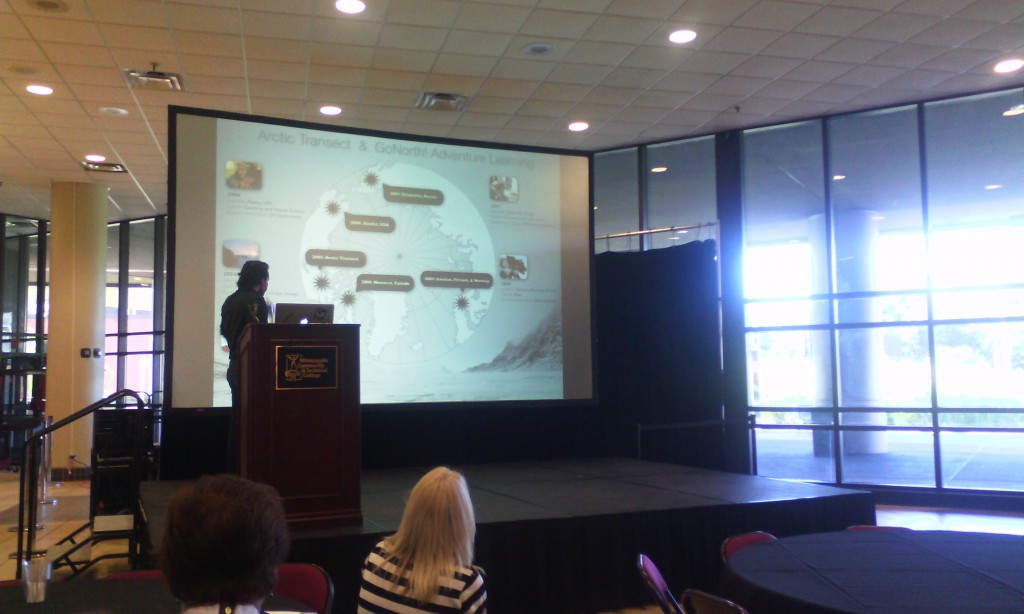
aaron doening
Engagement not completion
Design experience not product
Create change, not simply respond to it
He was a geography teacher : Dimitrina
Experience explore expand. Adventure based how to collaborate in ways we have not collaborated before pedagogical guidelines internet driven
Instructor – content – design
Today: first think is design, content, instructor. So how do we design learning environments is the most important one
Guide learners as designers. Constructivism. Design for meaning. Through the power of the story.
Geotetic design a learning environment learn geography using GIS
Situated movies (student-centered learning)
Grant Earthducation go to the most remote parts of the world to align their education with their culture, instead of what the government is downing as culture
Use of phone: whoever answers instructor’s question first, gets to pose the next question to the rest of the audience.
Design based research
Self-narrative, referencing the experience real world issues in real time
- reference knowledge . knowledge overlap. Technological pedagogical content knowledge.
Geotetic not only how prepare teachers, but desing learning environmwer of the story.
we explore: https://www.we-explore.com/
9.5 design as a learner.
the U Media Lab.
The Changing Earth. App GoX (instagram on steroids. tell their story through the app). How is this different from Google Earth
Raptor Lab (rehabilitate a raptor).
- design experiences
- build trust
- guide learners as designers
- recognize learners as experts
- encourage collaboration
- inspire self narrative
- reference the knowledge domains
- teach for change
- design as learner
adoering@umn.edi chasingseals.com @chasingseals
podcast pontification (audio version of blog self reflections)
Greg Steinke The U
A Digital Story Assignment using WeVideo

WeVideo is the Google response to iMovie cloud
The U is on Google email and thus google drive and all other google tools
The Center for Digital Storytelling. short videos, 3-5 min incorporate photographs with the author narration, reflection
Assignment (verbal directions). process (write a 2 page script, every page is about a minute of video), gather images that support the story; edit the script (rewrite); record audio to the script (use an app on the phone instead of WeVideo), WeVideo can edit the audio recording; edit the story, edit the photos to match the story; YourTube and/or Google+
working with faculty: is the digital story a good fit for your course? two questions: does the course have many writing assignments? does everyone have to do the same type of assignment? do you want to offer choices? do you want your students to share their work outside of the class? to you want to explore opportunities for students to develop 21 century skills?
google communities for sharing
wewideo has a tutorial at Center for Digital Storytelling
students can use the digital story for their eportfolio
the entire exercise is entirely based on mobile devices
time frame: scaffolding options
3d printing products were the tangible result of the project and the digital storytelling just the format to present
Google Drive master folder for the phone images and video; iOS apps: MoviePro, FiLMc Pro, VoiceRecord Pro (including mp3); Android: WeVideo
Storyboard template
Faculty Development Programs: Digital Storytelling Community of Practice
http://it.umn.edu/faculty-development-programs-digital-0
Poster sessions:
Brad Hokanson
http://dha.design.umn.edu/faculty/BHokanson.html
iPAD video kit:

Laurie Conzemius
Critical Thinking

ISTE: http://conference.iste.org/2016/
Joe Lau critical thinking
apps: Popplet blog.popplet.com http://www.popplet.com/ (mindmapping)
into the book: http://reading.ecb.org/
Kahoot – the token system. Polleverywhere https://blog.stcloudstate.edu/ims/2015/05/21/polls-and-surveys-tools-for-education/
Symbaloo https://www.symbaloo.com/home/mix/13eOcK1fiV zotero, easybib, delicious, diigo depending on the grade
youth voices; http://youthvoices.net/ replace social media like teachertube is trying to replace youtube
quandary games in education. https://www.quandarygame.org/ sim city
citizen science alliance http://www.citizensciencealliance.org/
Toontastic https://itunes.apple.com/us/app/toontastic/id404693282?mt=8 now free storytelling
coding and programming: https://www.makewonder.com/robots/dashanddot scratch
Osmo : https://www.playosmo.com/en/ $79.99 + give a set for free Stride principle as a parental involvement
chainlink;
kickword; https://play.google.com/store/apps/details?id=com.makario.wordkick
red herring (four categories) https://play.google.com/store/apps/details?id=com.BlueOxTech.RedHerring&hl=en
http://www.mathplayground.com/logicgames.html
http://www.mathplayground.com/thinkingblocks.html
evaluation:
telestory https://itunes.apple.com/us/app/telestory/id915378506?mt=8
explain everything http://explaineverything.com/
Exploring and Connecting 3D Printing to Teaching and Learning Jason Spartz, Saint Mary’s University of Minnesota
http://pubs.lib.umn.edu/minnesota-elearning-summit/2015/program/23/
http://pubs.lib.umn.edu/cgi/viewcontent.cgi?article=1023&context=minnesota-elearning-summit
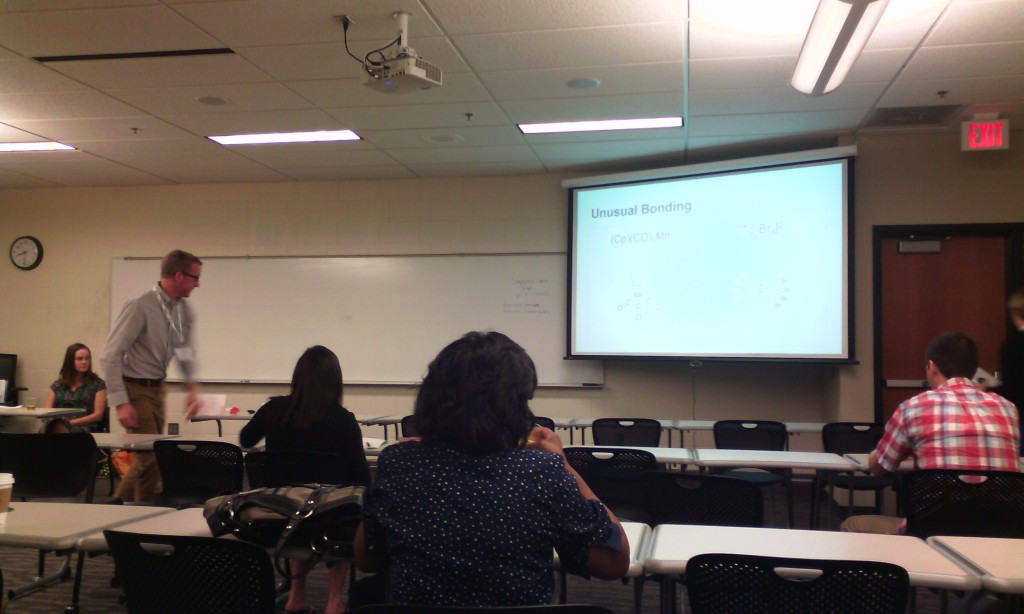
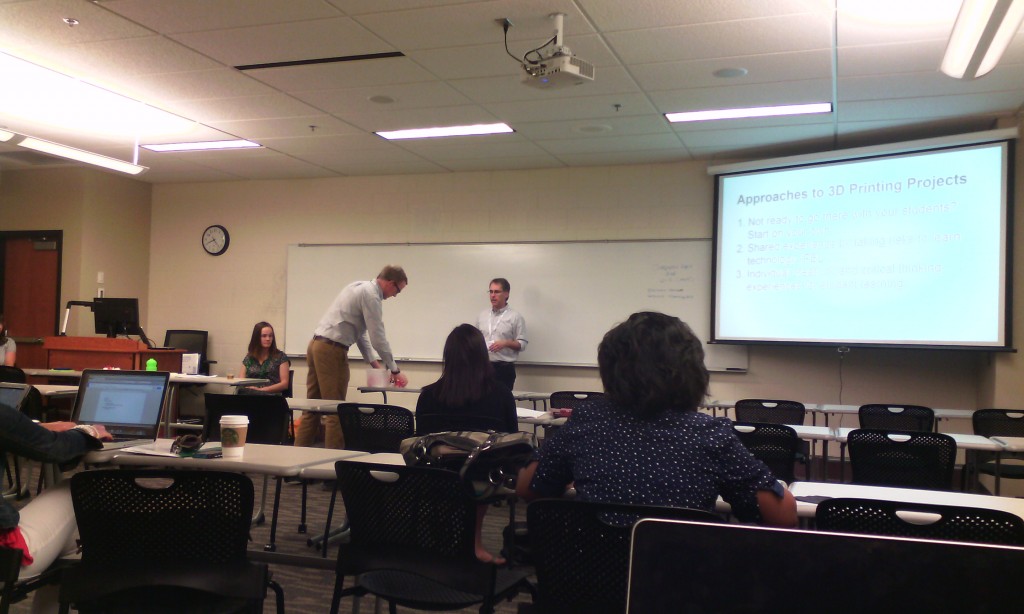
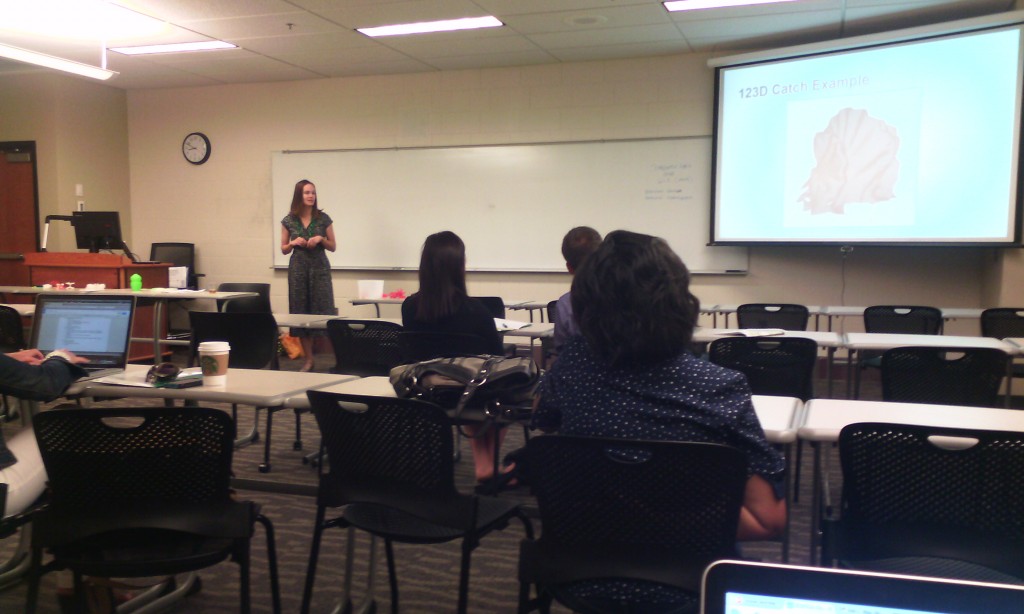
Jason Spartz, Saint Mary’s University of MinnesotaFollow
Lisa Truax, Saint Mary’s University of MinnesotaFollow
Karen Sorvaag, Saint Mary’s University of MinnesotaFollow
Brett Bodsgard, Saint Mary’s University of MinnesotaFollow
chemistry professor. 3D printing with different materials.
what else can be made (e.g. reaction vessel)
printing of atoms
crystalography dbase
Karen: pre-service teachers professor: how to use 3d printers and be comfortable with them. Steve Hoover. Thinkercad and Autodesk123D>
3D academy http://www.team3dacademy.com/index2.html. Pinterest board for3d Printing with resources
Lisa: graphic design. not intuitive. Rhinoceros (not free anymore). 123D strong learning curve. 3d printing will be incorporated in the curriculum. sculpture students and others don’t like fudging on the computer, but Adobe people love it. Some items takes up to 4 hours to print out. when working on the computer is difficult for some students to visualize the dimensionality.
collaborative learning opportunities.
no makerspace or fab lab. additional interest from the theater and business dept. 3d printing is connected to future work skills. new media ecology or media literacy set of skills.
the main presenter: build excitement and interest and gradually step back. how much material goes through and should we charge back. clean and maintenance involved; not too bad. better then a copier. plastic inexpensive. sizes with plastic – $25 and $50. how many project of a spool: depending on the size of the projects but considerable amount. two printers one art dept and one in the faculty dev area.
non profit visually impaired students. how 3d can make difference in special ed.
3d printing lab with access for everybody. ownership brings policy. where housed: neutral place.
only one printer is barely sufficient for faculty to figure out how to use it. purchasing two more if students and curricula to be involved.
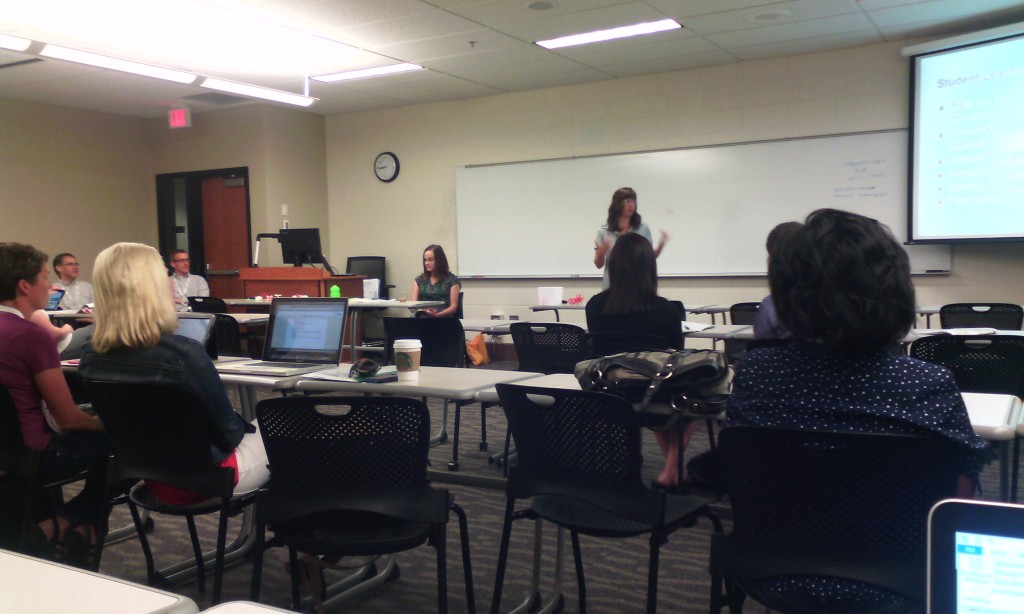



The Balancing Act: Team-Creating an eBook as an Alternative Method for Content Delivery Tom Nechodomu, University of Minnesota

Faculty Created digital stories – google “cultivaitng change series”
student created digital stories –
Susan Andre uses a slide titled “trust” to elucidate how the entire project was enabled. “trust” and “transparency” are sparse currency in the environment I work in. if she is right an ebook ain’t happening anytime soon at my place.
inclining habitat.
students involvement. use stipends. student artists. food for the video interviews. create a community, student centered.
people able to change the book.
copyright process; did you find it cumbersome. copyright permission center.
time span and amount of hours spent: 3-4 months per chapter.
Main speaker
David Wiley. Making Teaching and Learning Awesome with Open
MN Learning Commons
open educational resources
LUMEN
education – sharing feedback, encouragement with students passion about the discipline, yourself
open is not the same as free. free + permissions + copyright permission: 5 r = retain (make and own copies), reuse (use in a wide range of ways), revise (adapt, modify, and improve), remix (combine two or more), redistribute (share with others)
open:
free and unfettered access
perpetual, irrevocable copyright permissions
(look but don’t touch is not open)
tech enables OER permits
traditionally copyright materials on the Internet – not so good ; jet on the road
openly copyright materials on the internet _ yes: jet in the air
permission-less innovation. relatively inexpensive and broad permissions.
intellectual infrastructure of education: learning outcomes/objectives; assessments; textbooks. they are relatively expensive and narrow permissions.
disappearing ink strategies: buyback, rental, ebooks, online subscription
mad, glad, sad, rad: the grumpy cat. student success per dollar
opennetgroup.org/review
change in student learning: replace commercial with open books – small. realign, bigger change. rethink is the large change.
responsibilities:
attribution and meeting other license requirements
thin common cartridge: a way to bring the content to the CMS, but the content remains on the creative commons
disposable assignment: students hate doing them, instructors hate grading them. waste of time and energy
so what?
open education infrastructure: open outcomes, objectives, activities, educational resources
the culture of glued legos must be eradicated. open pedagogy. open credentialing model
summary: don’t settle for “affordable.” improve student outcomes. improve affordability. improve design / academic freedom
links generated from the discussion at my presentation:




















